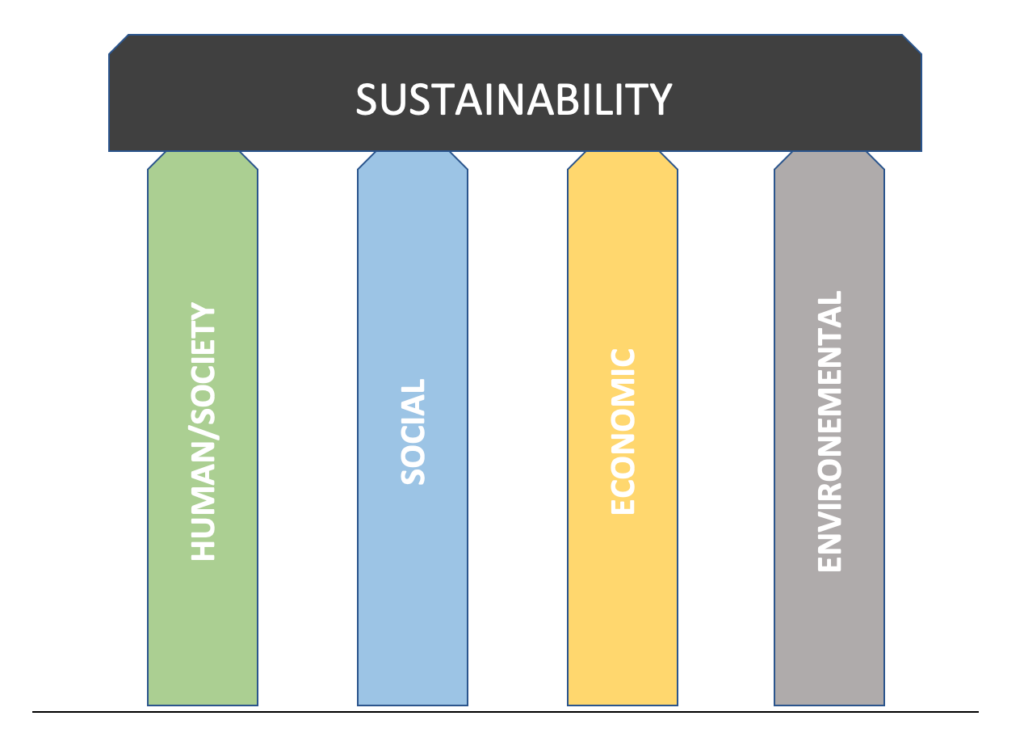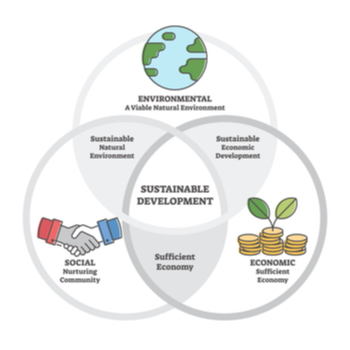
Sustainability has become ever-present in today’s world. But what is sustainability? How can we better understand it, what aspects of our world require focus and attention if it is to be delivered successfully?
Sustainability has relevance to individuals and businesses. It is important at a national and global level.
In today’s article, we’ll be looking at a standard model which can be used to describe sustainability and which uses four types of sustainability targets:
The four pillars of sustainability model.
In the article we’ll be covering.:
- What is sustainability
- Why is sustainability important?
- The four pillars of sustainability
- How do businesses incorporate the four pillars of sustainability
- Alternative sustainability models
- The Benefits of the four pillars of sustainability
- Issues with the four pillars of sustainability
Let’s get started.
What is sustainability
Firstly let’s answer a common question.
What is the definition of sustainability?
Let’s attempt to answer this question:
“Sustainability is used to describe how resources or a particular resource is preserved through the implementation of a particular program or project.”
How easy is sustainability to define?
Part of the problem is there is not a singular agreed definition of the term, and while the above looks to provide an answer, you will see different definitions if you explore the topic.
But why is this?
Part of the problem is because the term means different things to different people and in different contexts.
Therefore rather than tightly define the term, several models have been put forward to help provide understanding.
Far easier is the following question:
Why is sustainability important?
The answer to that question seems fairly obvious, doesn’t it?
We need to drive sustainability to protect our future, but there are a wide number of drivers behind it including:
- It helps meet and protect the future needs of both people & businesses by maintaining (or increasing) resources.
- Driving innovation
- Enhancing risk management
- Encouraging stakeholder engagement at all levels
- Encouraging cost reduction
- Sustainability is associated with high quality
- Provides a platform for differentiation with competition helping to retain customers, staff.
The four pillars of sustainability
The four pillars of sustainability is an important tool for helping to define a complete view of sustainability.
The model consists of four types of sustainability, which are termed pillars.
The model requires each to be strong if sustainability is to be delivered.
If one is weak, then the whole system becomes unstainable. You cannot successfully achieve sustainability by promoting one pillar to the detriment of another.
The four pillars are:
- Human Sustainability
- Social Sustainability
- Economic Sustainability
- Environmental Sustainability

Each pillar has unique characteristics and may require different approaches to deliver sustainment.
Three pillars of sustainability
The four pillars of sustainability concept was initially developed from the three pillars model, these pillars are:
- Growth of the economy
- Social inclusion,
- Balance of the environment
In recent years there has been considerable pressure to expand this model as it has been felt that it failed to represent the complex nature of modern society. Thus, a fourth “pillar” was required.
In 2010, The Executive Bureau of UCLG , promoted the use of a fourth pillar and suggested that Human (or culture) sustainability was as important as the other three pillars. This fourth pillar should be integrated with the other three, and organizations should utilize it for decision making.
As put forward above, each pillar is seen as interconnected with the others. Success, therefore, can only be measured by reviewing all of them together whether one is successful on its own or not.
Let’s take a look at each of the pillars in a little more detail.
Human sustainability
Human sustainability refers to the sustainment and improvement of human resources/assets or culture within society.
Typically, this could be achieved through enablers such as investment in services or capacity covering areas such as:
- Health
- Education
- Welfare
- etc,
The Human sustainability pillar targets investment in skills that function to sustain or improve the wellbeing of society.
Businesses will consider themselves part of the society within which they operate and target the promotion of appropriate values showing respect and regard for the people within that society.
However, not all businesses are viewed as positive by society; therefore, for some, any impact deemed positive could be considered subjective.
Societies can be both positively and negatively impacted by business. Key drivers for business, from aspects like sourcing, design, production through to sales channels, can require close scrutiny to garner their impact, positive or otherwise, on society.
Human sustainability explicitly focuses on the importance of human capital.
Simple capacity may drive a need for society to balance inputs and outputs in order to drive wellbeing for it’s population.
In practice, this means a need to balance growth against the effect of achieving it with a requirement to deliver security and sustainment for everyone.
Social sustainability
Social sustainability has a broader scope with a far-reaching view of the world we live in, accomodating communities, cultures, and concepts such as globalization. It also introduces the principle that society and the environment are mutually dependent.
Utilizing a broader view of community and culture, social sustainability relates to global aspects such as culture and uses investment in elements that establish and support our society to preserve social capital.
The goal of social sustainability is two-fold
- Recognize that we have an impact on others and on the world by what we do.
- To protect future generations.
You can see social sustainability encouraged through laws and regulations. For example, within business equality and rights policies, which aim to drive both social and economic equality.
Economic sustainability
Where Social and Human sustainability focus on human issues, economic sustainability focuses on monetary capital.
Economic sustainability is often described at a country or regional level.
It can be defined as the economic ability of a given country or region to support a specified level of economic production indefinitely.
In business, economic sustainability refers to maintaining or sustaining profitability through the use of its assets.
GDP is often utilized as a measure when analyzing the economic sustainability of a country (you can read about GDP here)
GDP varies from country to country, across the world and also varies from year to year.
For true economic sustainability, we should ask:
- Is indefinite economic sustainability possible?
- Is GDP the true measure of economic sustainability (i.e. does the nature of growth matter?)
- Is the long term goal of the economic system supported by GDP
Environmental sustainability
Environmental sustainability aims to enhance the welfare of the population through the strength and stability of our natural capital.
Examples of natural capital include resources such as:
- Fossil fuels
- Land
- Air
- Water
- Minerals
- Solar Energy
Environmental initiatives are commonplace and are usually one of the key terms people think of when thinking about sustainability.
There are examples of programs supporting environmental sustainability across government & business.
Governments will introduce policies supporting environmental sustainability. For example, policies driving a move away from fossil fuels to renewables for Energy creation is an obvious one.
Businesses will introduce processes, procedures, and governance to drive sustainability programs.
How can businesses use the four pillars of sustainability?
As you can see from the above definitions, many of these pillars have overlapping principles, and businesses will need to define appropriate systems and structures that tackle each one.
To support the delivery of sustainability, a series of questions should be asked; these should include:
- How is sustainability to be defined
- What sustainability goals will the organization implement
- How will success be measured?
- What are the relevant standards for providing assurance on sustainability, and how will they be implemented?
- What is the role of Leadership in sustainability and how will governance function
It has been argued that perhaps the easiest way for businesses to support sustainability is to produce products or services that directly contribute.
Alternative models of sustainability
Utilizing these four types of sustainability, the four pillars, while useful, is not the only route. As we discussed in this article’s introduction, there are numerous models that describe sustainability.
Some exist as minor complimentary revisions based on prior models, while others take their own, different approaches.
However, one common trait is that most describe a set of interrelated features that require equal levels of attention for sustainability to be a success.
Below are four alternative examples to the four pillars model described in this article.
1/ The three pillars of sustainability
The four pillars originated from this model (Brundtland report “Our common future”, principally proposed three pillars) – these were
- Economic growth,
- Social Equality
- Environmental protection

2/ The social sustainability model
This model has pillars that include:
- Ecological
- Cultural
- Economic
3/ The 5 pillars of sustainability
In this model, the pillars are represented by
- People
- Planet,
- Prosperity,
- Peace
- Partnerships
4/ The Four Dimensions of sustainability
This model endeavors to view sustainability as a series of interconnected task spread across four distinct groups which are:
- Economic view
- Social view
- Ecological view
- World view
What are the benefits of using four types of sustainability
Numerous benefits come from using a model that includes four types of sustainability; this includes:
1/ Provides a clear view of the status
2/ Helps to define clearer sustainability goals
3/ Multiple perspectives can be incorporated into sustainability programs
4/ Greater understanding of cause and effect
5/ Enables finely tuned responses such as policies and governance
Issues with using four types of sustainability
The four-pillar model is not without its issues; these include:
1/ Vague concepts without universally agreed on definitions. This results in concepts meaning one thing to one person and another to someone else.
2/ Success criteria for each pillar can be challenging to develop.
3/ Model fails to focus on all areas of influence (hence need for other models)
4/ Some elements of the model achieve greater attention than others leading to lopsided strategies (for example, a greater focus on economics than social).
5/ Assumes existing systems are compatible with long-term sustenance of life?
6/ Model does not facilitate prioritization.
7/ Assumes that where multiple programs exist (i.e. each country having their own program), they are complementary.
Summary
A world in which consumption outstrips production and where the environment becomes irreversibly damaged is clearly not acceptable.
Sustainability is, therefore, unavoidable, and governments and businesses have to address the problem through the development of policies and achievable goals.
The models that we’ve described in this article, notably the four types of sustainability, go some way to promoting a credible solution.
We hope that you enjoyed this piece. As ever we’d love some feedback, particularly if you’re working in a business to develop your own sustainability objectives or policies, we’d love to hear how your getting on.
You can reach us at twitter or in the comments section below.